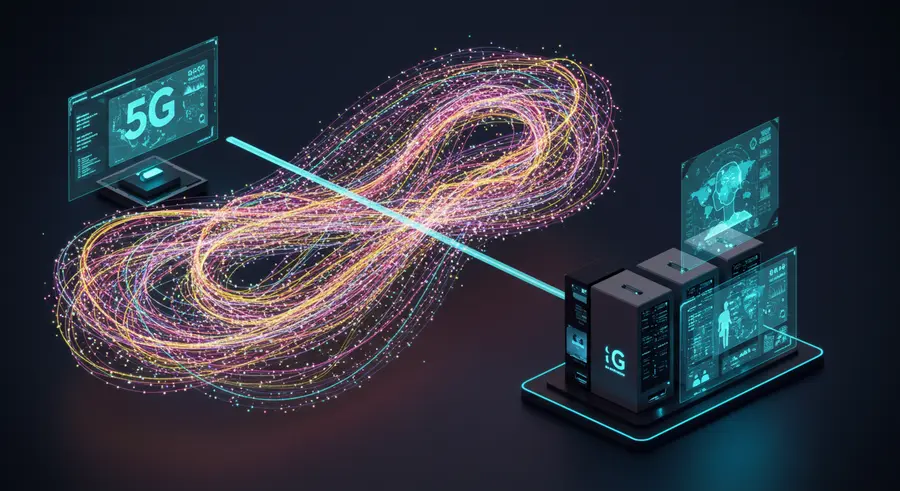The Unseen Powerhouse: How 5G and Edge Computing Fuel Spatial Experiences

Spatial computing, with its promise of seamlessly blending digital information with our physical world, demands immense computational power and incredibly fast data transmission. While technologies like Augmented Reality (AR), Virtual Reality (VR), and Mixed Reality (MR) provide the immersive interfaces, 5G and Edge Computing are the unsung heroes working behind the scenes. They create the robust, responsive, and reliable foundation necessary for these futuristic experiences to become truly practical and widespread.
Why Spatial Computing Needs 5G and Edge Computing
Imagine trying to interact with a complex holographic model in real-time, or collaborating with colleagues in a shared virtual space. Any lag or delay (latency) shatters the illusion of presence and can even cause discomfort (like motion sickness in VR). Spatial applications often involve:
- High-bandwidth data streams: Transmitting detailed 3D environmental data, high-resolution textures, and complex graphical overlays.
- Ultra-low latency requirements: Ensuring that user actions and environmental changes are reflected in the digital world almost instantaneously. A delay of more than a few milliseconds can break immersion.
- Real-time processing: Constantly analyzing sensor data, tracking user movements, and rendering complex scenes on the fly.
- Mobility: Users often need to move freely while using spatial applications, requiring consistent, high-quality connectivity.
Traditional cloud computing, where data travels to distant servers for processing, often can't meet these stringent demands, especially for mobile or widespread deployments. This is where 5G and Edge Computing step in. For a deeper dive into how AR is changing industries, check out Qualcomm's insights on Extended Reality.
5G: The Superhighway for Spatial Data
Fifth-generation wireless technology (5G) isn't just a faster version of 4G; it's a transformative leap in network capabilities, offering several key advantages for spatial computing:
- Enhanced Mobile Broadband (eMBB): Provides significantly higher data speeds (multi-gigabits per second) and greater capacity, allowing for the transmission of rich, high-fidelity spatial data without bottlenecks.
- Ultra-Reliable Low-Latency Communication (URLLC): Drastically reduces latency to as low as 1 millisecond, crucial for real-time interactions and seamless experiences in AR/VR.
- Massive Machine-Type Communication (mMTC): Enables a vast number of devices to connect to the network simultaneously, important for environments with many sensors and IoT devices contributing to the spatial experience.
- Network Slicing: Allows operators to create customized virtual networks tailored to specific application needs. For spatial computing, a slice could be dedicated to guaranteeing low latency and high bandwidth.
Edge Computing: Bringing the Brain Closer
Edge Computing complements 5G by moving computational resources and data storage closer to where they are needed – at the "edge" of the network, near the user or device. This architecture, often referred to as Multi-access Edge Computing (MEC), offers critical benefits:
- Reduced Latency: By processing data locally or nearby, edge servers minimize the round-trip time for data, leading to faster response times and smoother interactions.
- Bandwidth Optimization: Processing data locally reduces the amount of data that needs to be sent to centralized cloud servers, conserving network bandwidth.
- Improved Privacy and Security: Sensitive data can be processed and stored locally, reducing exposure to potential threats over long-haul networks.
- Enhanced Reliability: Edge deployments can continue to operate even if the connection to the central cloud is temporarily lost, crucial for mission-critical spatial applications.
Explore more about the convergence of these technologies at Nokia's overview of MEC and 5G for AR/VR.
The Synergy: 5G + Edge Computing = Transformative Spatial Experiences
When 5G and Edge Computing work in tandem, they unlock the full potential of spatial computing. For instance:
- Interactive AR Overlays: A field technician wearing AR glasses can receive real-time guidance and complex visual information overlaid onto machinery. 5G provides the bandwidth for the video stream and data, while edge servers process the video, identify components, and render the AR instructions with minimal delay.
- Collaborative VR Environments: Teams distributed geographically can meet in a shared virtual space for training or design reviews. 5G ensures smooth, high-resolution streams for each participant, and edge servers handle the synchronization of movements, interactions, and environmental changes, creating a truly shared sense of presence.
- Cloud Gaming & Immersive Entertainment: Complex games and interactive experiences can be streamed to lightweight VR/AR headsets, with the heavy lifting (rendering, physics calculations) done on powerful edge servers. 5G ensures a responsive and high-quality stream.
- Smart Cities & Autonomous Vehicles: Spatial computing plays a role in how autonomous systems perceive and interact with the world. 5G and edge computing are vital for processing the vast amounts of sensor data and enabling rapid decision-making.
Challenges and the Road Ahead
Despite the immense potential, the widespread adoption of 5G and Edge Computing for spatial applications faces challenges. These include the significant investment required for infrastructure deployment, ensuring consistent coverage and performance, developing standardized APIs and platforms, and addressing security and privacy concerns in a distributed computing environment.
However, the momentum is undeniable. As 5G networks become more prevalent and edge computing solutions mature, they will increasingly become the invisible backbone powering a new era of immersive, interactive, and intelligent spatial experiences. The journey is just beginning, but the convergence of these powerful technologies promises to reshape how we learn, work, play, and connect with the world around us. For further reading on the future of connectivity, the GSMA provides extensive resources on 5G innovation.
Back to Home